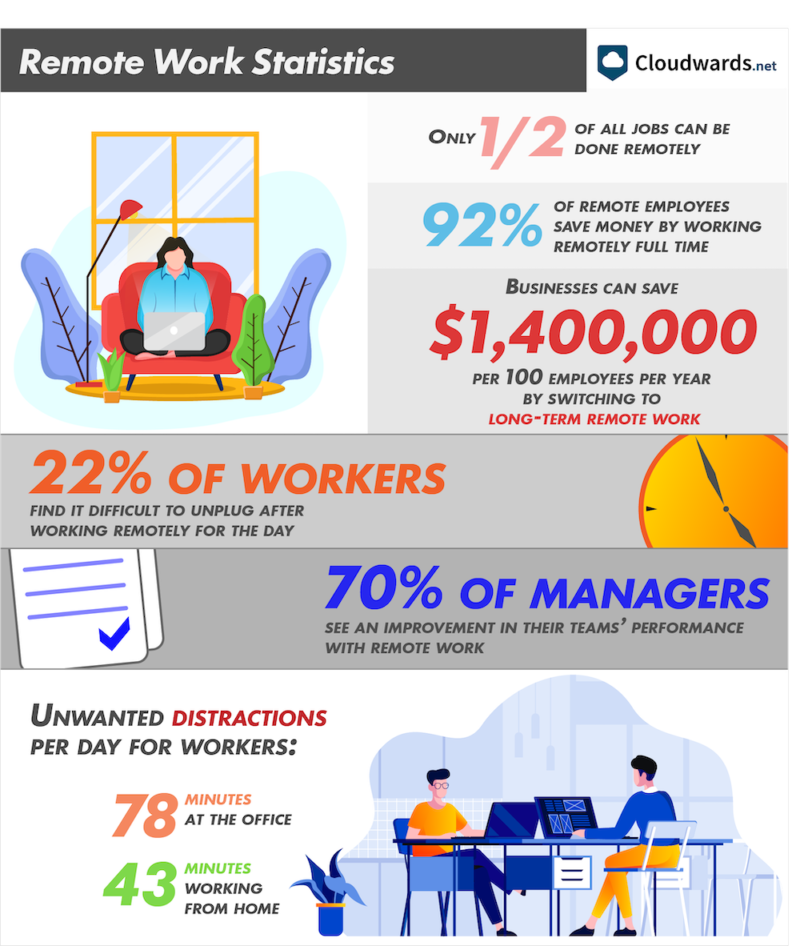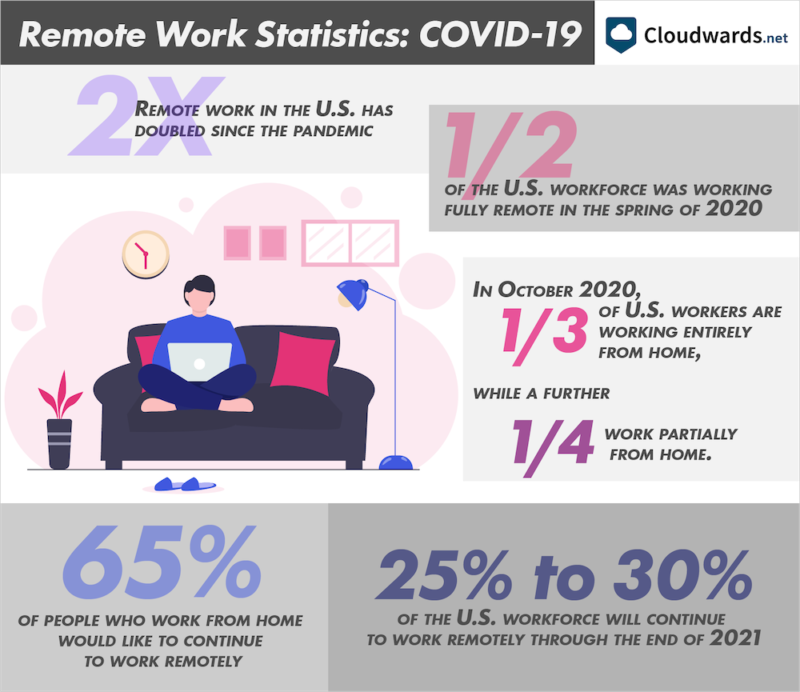Remote Work Statistics and Trends: What You Need to Know in 2025
More people are working remotely than ever before, largely due to COVID-19. In this article, you'll find 25 fascinating remote work statistics and trends about productivity, money-savings and work-life balance.
Remote work is becoming a standard part of daily life for an ever-increasing portion of the population around the world. It’s been a developing trend for years, or even decades now, but the COVID-19 pandemic has put the process into overdrive. Here, our team of productivity and security experts have collected 25 interesting remote work statistics to show you what this all means.
Remote work is often seen as a detriment to productivity, company culture and employee motivation. However, the statistics we’ve gathered below paint a very different picture. Although there’s certainly no clear-cut consensus, the majority of both workers and managers seem to be satisfied overall with the effects of more people working from home.

-
02/09/2022 Facts checkedSources verified.
Cloudwards refreshed this statistics article with up-to-date facts; added more statistics.
Remote Work Trends
Remote work is becoming more and more common, and it has been for a long time. There was an explosive growth in remote work even before the COVID-19 pandemic forced great numbers of people into working from home in 2020.
Remote work more than doubled between 2005 and 2015, increasing by 115% overall[7], according to a 2017 study by Global Workplace Analytics.
In 2015, telecommuters amounted to 2.9% of the U.S. workforce, which means that 3.9 million people worked remotely in that year. Besides technology making it easier and easier to not have to come into the office, another key driver in these trends is the fact that a larger number of people desire fully or partially remote positions[7].
Remote Work Statistics Before and After COVID
COVID-19 has accelerated an existing trend toward increasing levels of remote work. The need for social distancing due to COVID-19 may have unprecedented amounts of people out of the office.

However, remote work was on the rise well before the pandemic because of new technologies and shifting workforce trends. Experts estimate that a good portion of the U.S. workforce will continue to work remotely through 2022.
So, without further ado, let’s take a look at 25 statistics on remote work that paint a picture of the current state of working from home.
25 Remote Work Statistics
Here are 25 fascinating remote work statistics that we think may be of interest. If you’d like to take a look at the sources directly, you can click any of the citations or check out our “sources” section at the bottom of this article.
1. Is Remote Work Increasing or Decreasing?
Remote work is decreasing. In July 2021, Global Workplace Analytics found that out of those who worked remotely at the start of the pandemic, 73% had returned to the office for at least one day per week.[9]
As remote work has become more common during the pandemic, it reached a peak in the spring of 2020, when 51% of the workforce was working fully remote.[1]
Percentage of U.S. Workforce Working Fully Remote, Spring 2020
Source: Gallup
2. How Many People Work From Home?
In September 2021, 25% of the U.S. workforce was working remotely full time, while an additional 20% work partially from home.[8] Since the spring of 2020, remote work has been steadily decreasing.
3. How Much Has Remote Work Increased Due to COVID-19?
According to Gallup, remote work in the U.S. has doubled since the start of the pandemic, with the average worker having 5.8 remote workdays per month (or in the 20 workdays per month) in August 2020, compared to 2.4 before the pandemic[5]. However, the tendency is now trending downward from the all-time high in the spring of 2020.

4. Will the Current Trend for Remote Work Continue After 2020?
This moves into the realm of analysis and predictions, but when asked by Gallup in September 2021, around 88% of respondents said that they anticipate working from home at least partially for the foreseeable future.[8]
5. Do Remote Workers Want to Continue Working From Home?
In the U.S. in 2021, 91% of people who currently work from home said they would like to continue to work remotely in the future.[8] This is up from 65% in 2020,[1] which suggests that people are getting more comfortable with remote work. Additionally, 96% of remote workers would recommend it to a friend.[10]
Whether or not people actually like the new normal of remote working has been a point of contention. Some people hate the isolation, but most remote workers love the increased freedom and lack of commuting.
6. Do People Save Money by Working From Home?
A whopping 92% of remote employees say that they save some amount of money by shifting to working remotely full time. That it can save you significant amounts of money is an unexpected benefit of remote working.
Here’s how it breaks down: 19% of remote workers say they saved significant amounts of money from remote working, 25% saved moderate amounts, 29% saved small amounts and finally, 19% saved minimal amounts[4].
The savings come largely from not having to commute to work. However, other factors also play into this, such as less money spent on meals and things like dry cleaning.
7. How Much Money Can Businesses Save by Switching to Remote Work Long Term?
According to Global Workplace Analytics businesses can save $1,400,000 per 100 employees per year by switching to remote long term.[4] At the end of the day, it’s the bottom line that matters to a business, and the savings are significant.
8. Who Is Still Working From Home?
In July 2021, over a year into the pandemic, Global Workplace Analytics found that of the 73% of employees who had returned to the office, 60% were millennials. The second largest group was Gen X at 25%, followed by Boomers at 8% and Gen Z at 7%.[9]
9. How Much Time Do Remote Employees Save by Not Commuting to the Workplace?
When workers get their preferred amount of remote work days, they save an average of 75 hours per year in avoided commute time. Of this time, 47% of it is used to get more work done, resulting in increased productivity.[4]
A long commute is the bane of any office worker’s existence. One of the primary benefits of working from home then is completely eliminating this concern. Not only is this great for employees and managers due to saved time and increased productivity, but it also leads to an overall reduction in greenhouse gas emissions that workers produce.
10. Remote Work Productivity Statistics
The amount of distractions is another major concern for remote workers. The default assumption is often that someone’s home has more potential for distractions than the office, but this is not borne out in the data. Remote work statistics indicate that there are actually fewer distractions at home than in the office space.
In fact, on average, respondents to the Global Workplace Analytics study estimated that they experience 78 minutes of unwanted distractions or interruptions per day when working at the office, compared to 43 minutes per day when working from home[4].
When asked by Gallup, 29% of remote workers in September 2021 said that they experienced fewer distractions at home than at the office.[8]

11. Do Remote Workers Work More or Less?
According to the 2021 remote work report, 55% of employees said that they work more hours on average from home than when at the office. Despite this, only 11% of managers are concerned about increased rates of burnout.[9]
Although the increased productivity and fewer distractions that the vast majority of employees experience when working remotely should lead to shorter workdays, in reality it has done the opposite.
12. Working From Home Productivity Statistics for Teams
In 2020, a slightly larger portion of leaders and managers were happy with their employees’ work-from-home results than the remote workers themselves. Additionally, 70% say that their teams’ performance is as good or better than it was before switching to remote work, which was 2% higher than what remote workers said.[4]
However, this changed in 2021. Global Workplace Analytics found that although less than 1% of employees felt less productive when working at home, 36% of managers were concerned about productivity and reduced focus.[9]
13. How Productive Are People When Working From Home?
In May 2020, an entire 77% of employees said that they were “fully productive” when working from home, meaning that they get as much or more done when compared to going into the office every day. Similar to the previous statistic on how successful remote workers feel when working from home, productivity is another huge concern when making this switch.
Again, there’s a huge gap between generations, with Baby Boomers, Gen X and Millennials feeling the most productive at home (83%, 85% and 76%, respectively).
The two extreme ends of the age spectrum, namely the Silent Generation and Gen Z, think they are far less productive, with only 37% and 44%, respectively, feeling like they are getting as much done at home.[4]
This increased even further as the pandemic continued, with a full 90% of remote workers reporting that they were as or more productive when working from home, in Owl Labs & Global Workplace Analytics’ 2021 remote work survey.[9]
14. How Many Jobs Are Compatible With Remote Work?
Only 56% of all jobs can be done remotely. With the COVID-19 pandemic, whether or not your field is compatible with a remote work approach can be a significant factor. This means that about half of the workforce is lucky enough to be able to work remotely, and thus, are protected by various stay-at-home measures.[3]
15. Are Organizations Adapting Well to Remote Working?
In a survey of HR and engineering leaders conducted by Terminal, only 37% of respondents said that they lack a centralized way to manage their projects and remote worker teams (read our best project management software article).[2] Shifting an entire organization’s workflow into remote work has been a huge challenge for many this past year, though most companies have handled it well.
Additionally, Global Workplace Analytics found in its 2021 remote work report that 38% of employees felt that their employer has upgraded their capabilities for remote video meetings and collaboration.[9]

16. How Has COVID-19 Impacted Work Culture in 2020?
In Terminal’s study of leaders, only 27% of respondents said that their organization still has a strong work culture with the increased levels of full-time and part-time remote work[2]. This means work culture has taken a significant hit in most businesses due to the increased levels of remote work in 2020.
As people have become more used to remote work, this number has only increased. In Gallup’s September 2021 study, 54% of workers said they believed that their company’s culture would be unchanged by remote work, while 12% believed it would improve and 33% predicted it would deteriorate.[8]
17. Can Team Leaders Properly Evaluate Remote Employees’ Productivity?
only 19% of leaders say that they struggle to evaluate an employee’s productivity when working from home.[2] Although it can be difficult to be sure how much work is actually getting done when everyone is working remotely at home rather than in the office, this isn’t an issue for most companies.

18. How Do Team Leaders Track Remote Workers’ Time?
A solid majority of managers (78%) prefer simply trusting their remote employees to self-report accurate timesheets rather than to rely on controversial time-tracking software[2]. However, even before COVID-19 and the remote working boom, some managers were using time tracking software to track employees’ work habits.
19. Do Workers Have Adequate Access to Remote Working Tools?
Only 72% of remote workers in 2020 said that they had access to all the tools they needed when working remotely, which meant that almost a quarter of remote employees needed better remote working conditions.[4]
This remained an issue in 2021, with only 38% of respondents telling Global Workplace Analytics that their employer had improved video and collaboration tools since the start of the pandemic.[9]
Depending on the job, remote workers may need certain tools to get all their tasks done and stay productive. This can range from ergonomic chairs and standing desks to hardware like dual or ultrawide monitors. People who work remotely might even need access to certain software solutions, like a VPN, to connect to the office network (check out our best VPN list).
20. In What Parts of the World Are People Happiest to Work From Home?
On average, workers in the Americas are the happiest to work from home, with their ideal balance being two-and-a-half remote workdays per week, which equates to working remote half-time.
The Europe/Africa/Middle East region is second, with people preferring to work remotely at least 2.3 days per week on average, while the Asia/Pacific region is dead last, wanting only 1.8 remote workdays per week on average[4].
Given how different work cultures are around the globe, it should come as no surprise that there is no unified global opinion on the positives and negatives of remote work.
21. How Many Remote Workers Are Willing to Give up Their Office Desk?
Depending on the type of office, 48% to 60% of workers say that they’re fine with not having an assigned desk if they get to work from home as much as they want[4]. If you work from home most of the time, it’s only natural that you don’t have a reserved workspace at your office for the days that you come in. Clearly, this is a trade-off that not everyone is comfortable with.
Even more significant is the number of employees willing to take a pay cut to continue working remotely. When asked in Global Workplace Analytics’ 2021 report, 46% of remote workers said they’d be willing to take a 5% decrease in pay if it was required to keep working remotely. Of those, 40% would accept a 10% pay cut, while 37% would take a decrease even larger than that.[9]
22. How Many Office Workers Would Change Jobs if Offered More Flexible Schedules?
According to Gallup, just over half of all workers (54%) would be willing to quit their current job and take a new position if it offered more possibilities for remote work and a more flexible schedule[5]. That means that not only can remote work increase employees’ productivity and work-life balance, but it can also be a key part of a business managing to retain talent.
Furthermore, in Global Workplace Analytics’ 2021 remote work report, 57% of respondents who had returned to the office would prefer to work from home full time. This is also borne out by the responses from those who had changed jobs in the past year, with 84% citing increased flexibility in where they work as the primary reason for the change.[9]
23. What Are the Problems With Working From Home?
The most common challenge for remote workers is finding it difficult to unplug after a day’s work, with 27% of respondents to Buffer’s remote work study saying they have this problem.
However, 16% say loneliness is the biggest challenge, which shows us that many people rely on the social environment of the office on a day-to-day basis. Also, 16% say that they find it difficult to properly collaborate and communicate with other team members, while 15% claim that they struggle with distractions at home[6].
Challenges With Remote Work
Source: Buffer
24. Will Forcing Employees Back to the Office Drive Them Away?
When asked by Global Workplace Analytics in July 2021, a third of remote workers said that they were extremely likely (a five on a scale of one to five) to quit their job if they were forced to go back to the office.[9] If you include those who answered with a likelihood of four out of five, the number rises to roughly half (49%).[8]
25. Who Are Quitting Their Jobs?
Around 25% of employees have quit their job during the pandemic, with Gen Z making up a whopping 62% of these respondents. By contrast, only 4% of those who quit belong to the Baby-Boomer generation.[9]
Final Thoughts
Taken as a whole, these statistics paint an overall positive picture of the effects of increased remote work. There are still significant challenges to overcome, such as organizations adapting their workflow management to better suit remote work or the ability to maintain a solid work culture. However, managers and employees alike seem pleased with the effects of working from home.
We have a piece with some work from home tips, in case you want to start working remotely.
If you found these statistics enlightening and would like to read more like them — albeit about a different topic — you can check out our previous entry in this series that covers ransomware statistics and trends, dive into our VPN statistics piece or see how AI is progressing in our AI writing statistics article.
What do you think of these remote work stats? Were you surprised by anything? If so, which figures stood out to you the most? Let us know in the comments below. As always, thank you for reading.
Sources:
- Gallup
- Terminal
- Global Workplace Analytics
- Global Workplace Analytics
- Gallup
- Buffer
- Global Workplace Analytics and Flexjobs
- Gallup
- Owl Labs
- Nira
FAQ: Statistics on Remote Work
On average, yes. Not only do most workers report increased levels of productivity when working from home, but they also save time on things like commutes, parts of which are then spent working more.
According to Buffer’s study of remote workers in 2019, the largest struggle that remote employees face is not being able to properly unplug after work. Loneliness, trouble collaborating or communicating, plus distractions at home follow close behind[6].
Loneliness, distractions, and the inability to relax after work have been reported as the biggest issues workers face when working form home.
Around 83 million people in the United State were working fully remotely in 2021, with another 67 million working partially from home.


